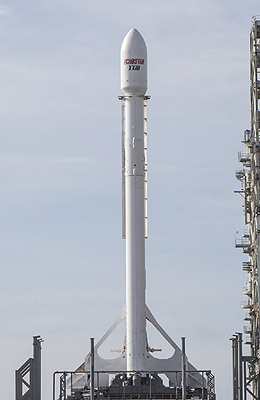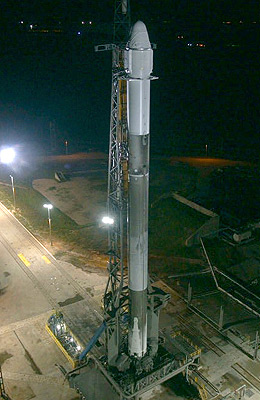Thank you very much for visiting Gunter's Space Page. I hope that this site is useful and informative for you.
If you appreciate the information provided on this site, please consider supporting my work by making a simple and secure donation via PayPal. Please help to run the website and keep everything free of charge. Thank you very much.
Falcon-9 v1.2(ex) (Falcon-9FT(ex))
 Falcon-9 v1.2(ex) (EchoStar 23) |
 Falcon-9 v1.2(ex) (Dragon CRS-15) |
Falcon-9 v1.2 or Falcon-9FT is a liquid fueled orbital launch vehicle for medium sized missions, which is developed by SpaceX (Space Exploration Technologies Corp.). It is a improved version of the Falcon-9 v1.1(ex) launch vehicle without reusable first stage for increased performance. Both stages are Kerosene / LOX fueled.
The Falcon-9 v1.2 is mostly identical to the Falcon-9 v1.1, but features some improvements. The Merlin-1D are uprated to provide thrust increased by 15%. Propellant densification is introduced to increase the fuel load and the upper stage tank volume is increased by 10%. This results in overall 30% increase in performance, alowing stage 1 recovery also on GTO launches.
The first stage is powered by 9 of the SpaceX built uprated Merlin-1D engines with regenerative cooling. The Falcon-9 is offered with a 5.2 m fairing.
Launch site for low inclination launches is Cape Canaveral launch pad SLC-40. High inclination launches are performed from Vandenberg AFB launch pad SLC-4E. An additional launch site at Boca Chica near Brownsville, Texas, was also under construction, but this site has in 2018 been dedicated for the Starship development.
The expendable version is only used for rare cases, where the full performance is needed, so that no fuel for the powered landing remains or in cases, where older models are expended, because they were superseded by newer versions.
| Version | Stage 1 | Stage 2 |
|---|---|---|
| Falcon-9 v1.2(ex) (Falcon-9FT(ex)) | Stage 1 (str.) / 9 × Merlin-1D (upr.) | Stage 2 (str. +) / Merlin-1D-Vac (upr.) |
| Performance (kg) | LEO | LPEO | SSO | GTO | GEO | MolO | IP |
|---|---|---|---|---|---|---|---|
| Falcon-9 v1.2(ex) (Falcon-9FT(ex)) | 6700 | - |
No. TypNo Type Serial/Core Date LS Payload
31 1 Falcon-9 v1.2(ex) B1030 16.03.2017 CCK LC-39A EchoStar 23 34 2 Falcon-9 v1.2(ex) B1034 15.05.2017 CCK LC-39A Inmarsat-5 F4 (GX 4) 38 3 Falcon-9 v1.2(ex) B1037 05.07.2017 CCK LC-39A Intelsat 35e 46 4 Falcon-9 v1.2(ex) B1036.2 23.12.2017 Va SLC-4E Iridium-NEXT 116 / 130 / 131 / 134 / 135 / 137 / 138 / 141 / 151 / 153 50 5 Falcon-9 v1.2(ex) B1038.2 22.02.2018 Va SLC-4E Paz / MicroSat 2a / MicroSat 2b 56 6 Falcon-9 v1.2(ex) B1043.2 22.05.2018 Va SLC-4E Iridium-NEXT 110 / 147 / 152 / 161 / 162 / GRACE-FO 1 / GRACE-FO 2 57 7 Falcon-9 v1.2(ex) B1040.2 04.06.2018 CC SLC-40 SES 12 58 8 Falcon-9 v1.2(ex) B1045.2 29.06.2018 CC SLC-40 Dragon CRS-15 / ECOSTRESS⇑ / Bird BTN↑ / Bird MYS↑ / Bird PHL↑ F failure P partial failure p partial failure (prime payload in usable orbit) Launch sites: CC = Cape Canaveral Air Force Station, Eastern Test Range, Cape Canaveral, Florida, USACCK = NASA John F. Kennedy Space Center, Cape Canaveral, Florida, USA
Va = Vandenberg Air Force Base, California, USA

